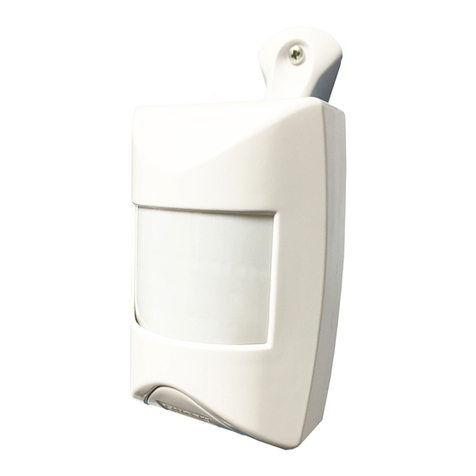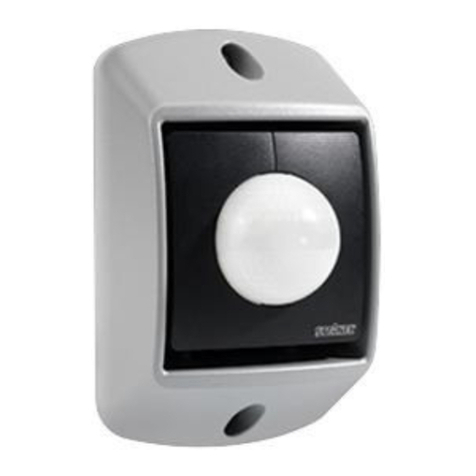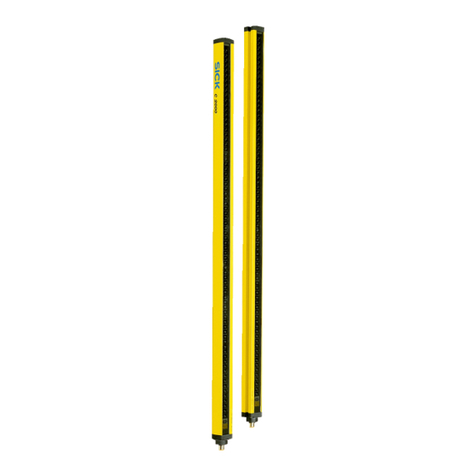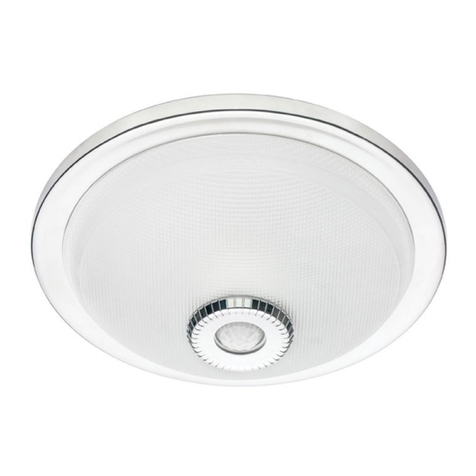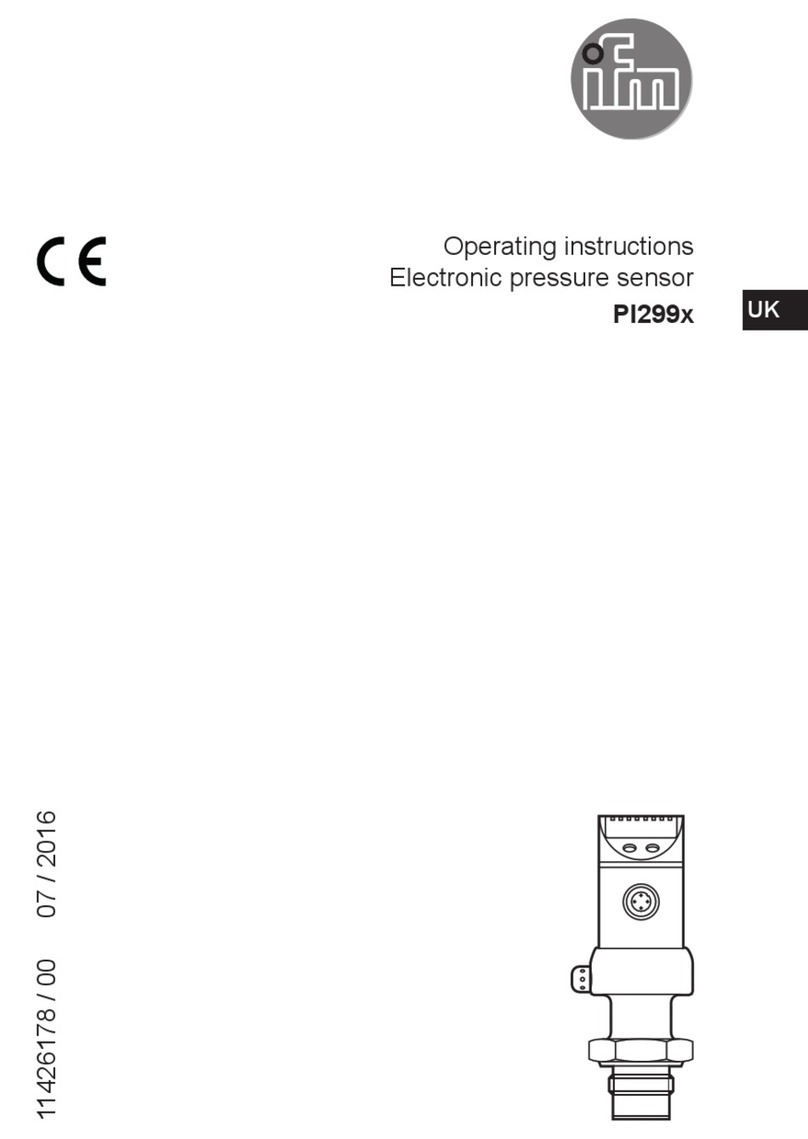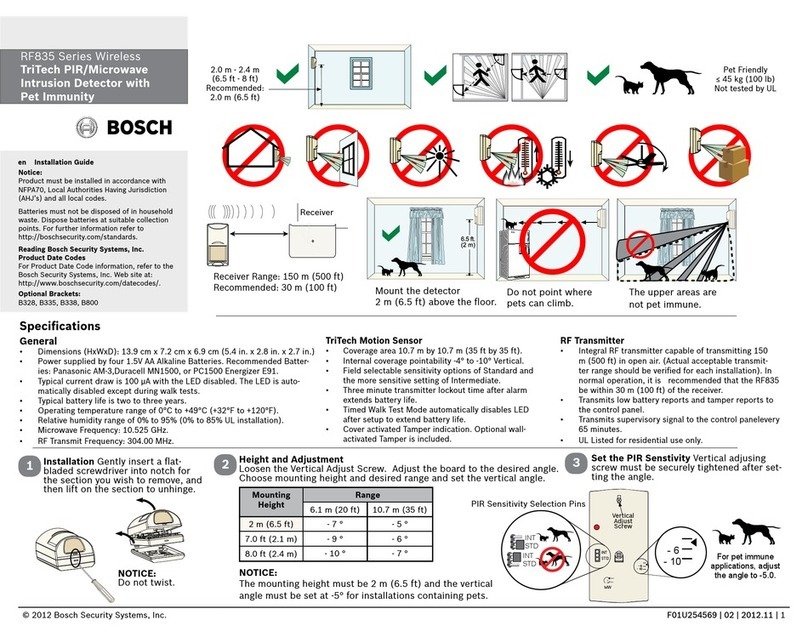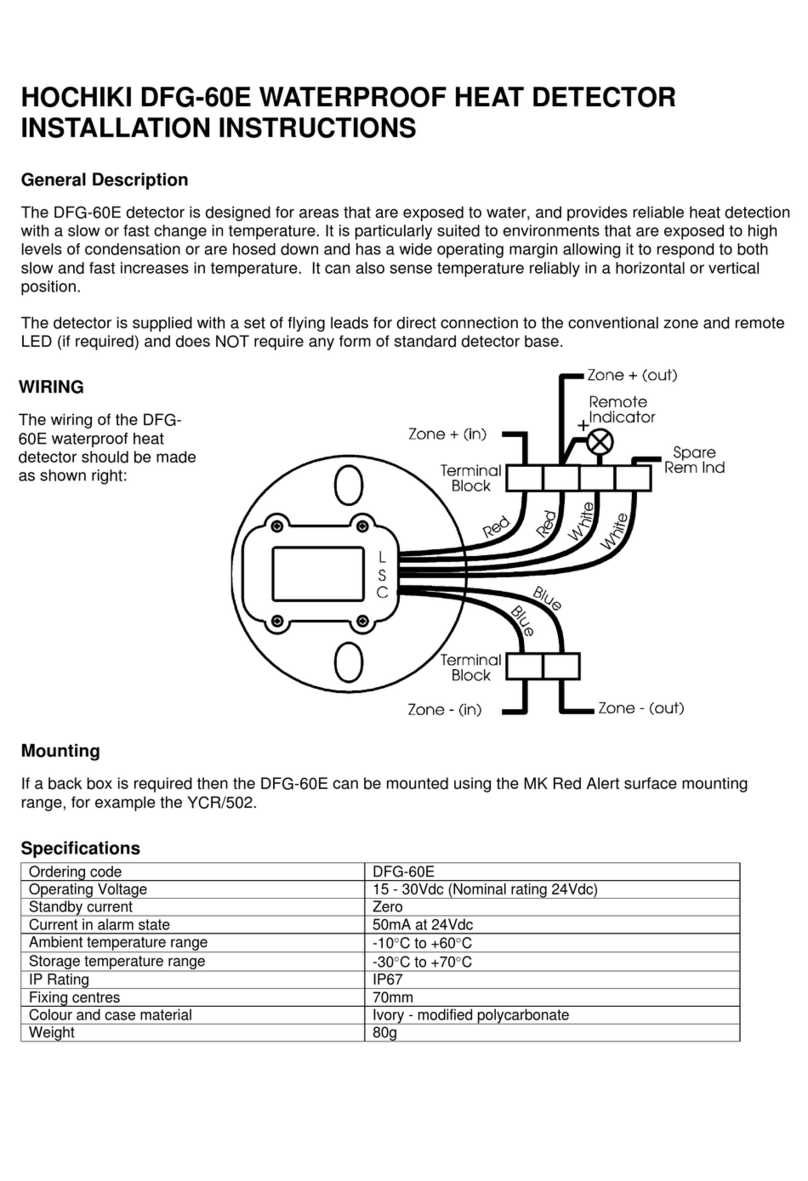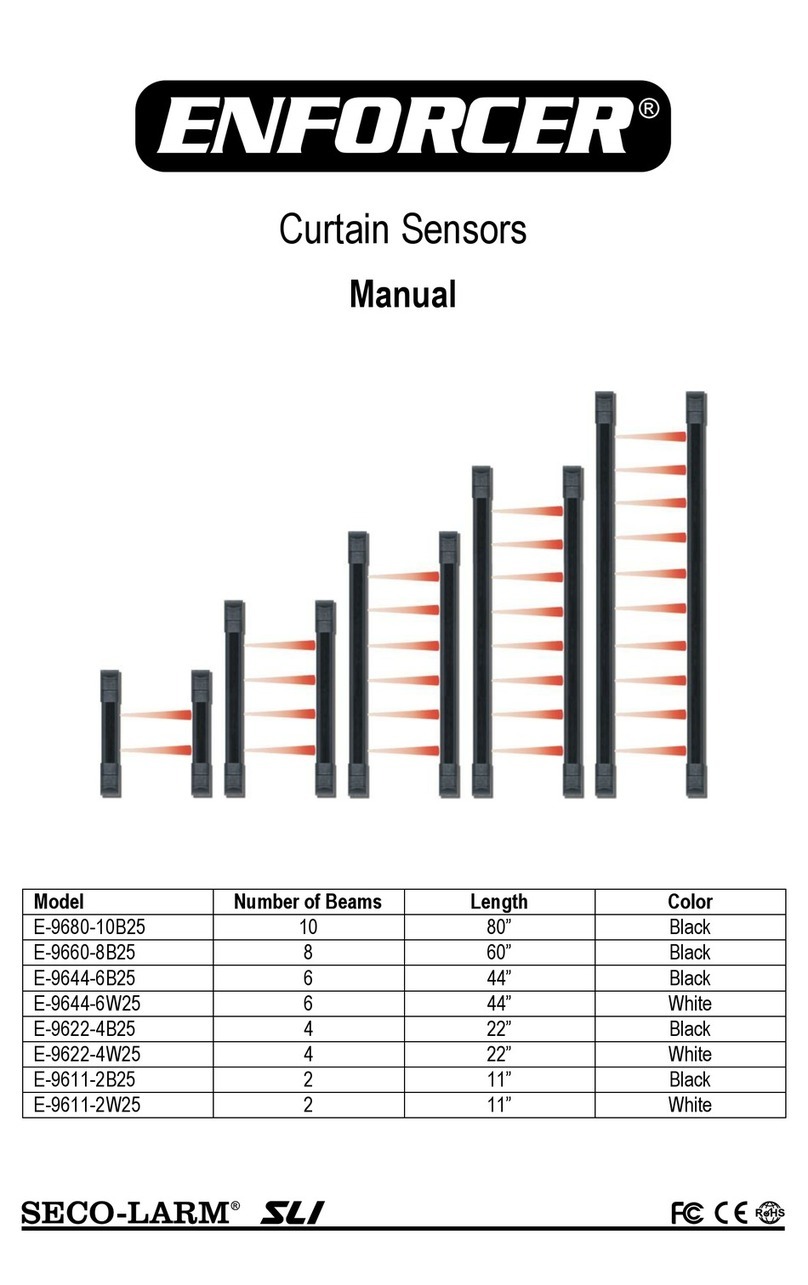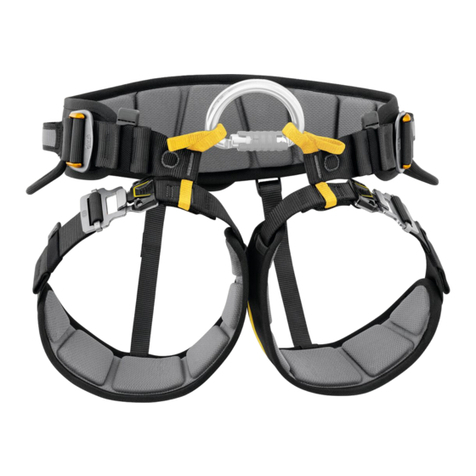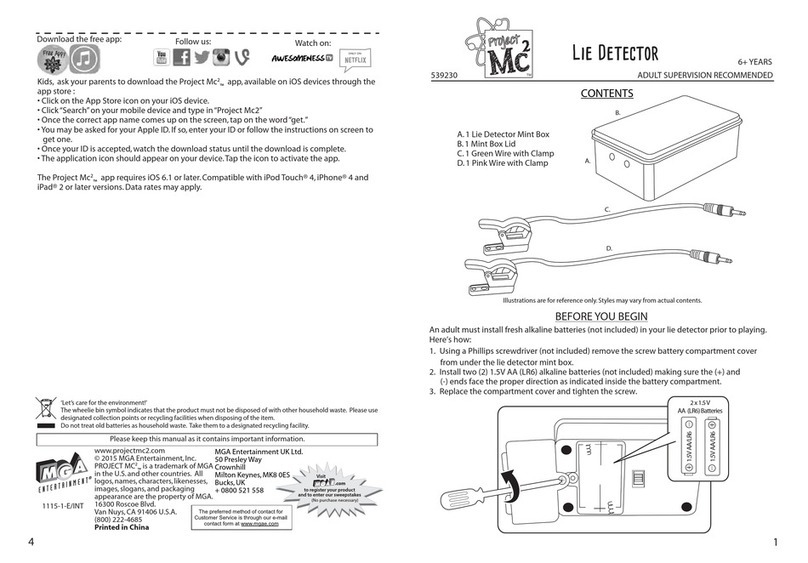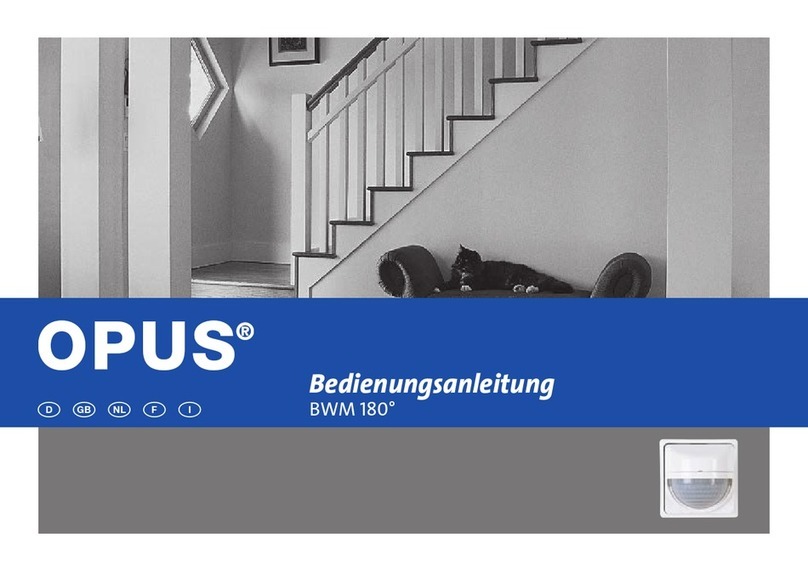Prime Controls FLUXIMITY DS71 User manual

MULTI-FUNCTION
INDICATOR (RED,
GREEN, AMBER)
POWER
INDICATOR
(GREEN)
FLUXIMITY
OPERATING INSTRUCTIONS
MODEL DS71 or DS72 DOUBLE SHEET CONTROLLER
MODEL PN18 Sensor Probe
The Fluximity detector is a
unique double metal detection
system that utilizes an external
magnet as the operating signal
to measure metal thickness.
For example it is ideal to use
the magnetic field of a magnetic
conveyor that transports metal
blanks from process to process.
If no magnet is available, one
can be positioned so that the
blank is in contact, while the
Fluximity sensor is in position approximately 12mm away to monitor the strength.
CONTROLLER
There are four Fluximity controllers (DS71 –DS74). Only Models DS71 and DS72
Double Sheet Controllers are explained is this instruction sheet. The Fluximity system
includes a microcontroller based control module in a 18mm threaded aluminum
housing. The Controller is connected to a family of magnetic detection sensors through
an 8mm receptacle on the face of the Controller (depicted above). A four-pin 12mm
connector at the rear end provides connections for power, ground, single output and no-
double output. The Model DS71 provides current
sourcing outputs while the DS72 provides
current sinking outputs; otherwise the two units
are functionally identical. Status and setup
controls on the face include a green power
indicator, a multi-function/multi-color LED indicator
and a pushbutton switch.
The DS71/DS72 requires power that ranges from 12 to 24 DC volts at 40mA for power.
For a Model DS72 add the anticipated output PnP load current to the 40mA when sizing
a power supply. The load current should not exceed 100mA.

2
(Pico Style)
SENSOR PROBE
Currently Prime has only one magnetic probe, the Model PN18 that operates with the
DS71/72. The PN18 is a passive receiver sensor. It requires the operating signal from
an external magnetic source. Ferrous metal from .002 to .100” is detectable with the
PN18, if the external magnetic strength is sufficient to saturate a single blank with
additional magnetic flux available for a double metal blank will cause the sensor to
measure a difference.
INSTALLATION
Installation of the individual components of the DS71/DS72 system is covered in the
following paragraphs:
DS71/DS72 Control Module Installation
The DS71/72 Controller module is designed to mount with a simple bracket, where
convenient, between the probe
and a higher level controller
such as a PLC. Avoid
mounting locations with
excessive heat and vibration.
The control and probe
separation should not exceed
the length of the Model
CBL110-2 cable or two meters.
Any 18mm proximity probe
mounting bracket can be used
to install the controller. Prime’s 18mm right angle bracket model number is BR18SR.
Mount the control so the control face with the LED indicators and pushbutton is in view
and accessible. To connect the DS71/72 into a control system, use Prime Model
CBL104-3 cable/connector. The cable length is 3 meters. Prime can manufacture a
CBL104 cable/connector with additional length. The special order may take one week
to complete.

3
Probe Installation
Mount the probe so that the metal passes between the probe face and the magnetic
source (conveyor). We recommend the initial probe gap to conveyor belt should be
12mm (.5”) or less. Do not hard mount the probe bracket at this time. With no metal
present the probe must detect at least 100 gauss from the magnetic conveyor. It is wise
to leave the probe mounting loose until the ideal location is determined using the Meter
Mode feature cover on page 5.
The Models DS71 and DS72 with the Model PN18 Single probe Double Sheet Detector
can operate without the probe touching the target metal. It uses the residual magnetic
field that attracts the metal to the conveyor. The magnet acts like a transmitter in a dual
probe detector. The Magnetic field will permeate through the metal blank. The
thickness of a non metallic belt will not adversely affect the magnetic strength as long as
it is blank is held closely to the belt surface. The unit must be calibrated after the gap is
established. If the gap is too large, the unit will not calibrate. Use the meter mode
(page 5) to determine the maximum gap.
We recommend you always locate the sensor to achieve maximum coverage of the target metal
blank when calibrating. Calibration at a location where the maximum field is not blocked may
cause false doubles. During production the metal may move to a point where more flux is
covered. This is especially true when the shape of the blank varies. Typically the blank should
cover the magnetic to the PN18 for approximately 50 mm (2”). If the target is smaller than
50mm, then locate it where the maximum coverage is located using the meter mode. Calibrate at
that position.
Electrical Wiring
The connection between the probe and the controller requires a Prime Controls adapter
cable model CBL110-2. The cable has a connector at either end and does not require
external wiring. Probe and control separation should be within the 2 meter cable length.
Power to the controller and the outputs connect through an industrial standard male,
four-pin, 12mm connector. For noise immune connection use Prime Controls specified
Model CBL104-3 cable.
The CBL104-3 pin-out is as follows and the connected individual wire colors:
Pin 1 - Power Brown wire on standard cable
Pin 2 - Single Output White wire on standard cable
Pin 3 - Common Blue wire on standard cable
Pin 4 - No-double Output Black wire on standard cable
Cable shields should not be strip from wires more than 50mm or 2 inches to maintain
noise immunity. Route the cables away from any high power wiring and machinery to
maintain noise immunity. Make sure the Pin 3 Common (blue) is uninterrupted to the
common of the source power supply.

4
MULTI-FUNCTION
INDICATOR (RED,
GREEN, AMBER)
POWER
INDICATOR
(GREEN)
Apply Power
When power is applied, the green LED indicator is continuously ON.
When initially powered up, the DS71/DS72 controller displays the firmware version
number by flashing the multi-function/multi-color LED indicator, first red then green
(See FIRMWARE VERSION later in this document on page 8). When troubleshooting
with Prime Controls, it is helpful to know the version number. The controller then
checks for a valid probe. If a fault is detected, it could be one of the following problems:
a) the probe is not connected; b) there is an open connection in the cable to the probe;
c) weak or no magnetic signal present. The multi-function indicator will flash red at a
rate of 10Hz until the fault is cleared. If no fault is detected the controller goes into
normal the sensing operation. Normal indicator colors are covered on page 8. If the
magnetic field signal is strong the multi-function indicator will be off. (this assumes the
probe face was mounted within 50mm of the magnetic conveyor.)
PUSHBUTTON OPERATION
The small pushbutton mounts flush with the
face of the unit to insure no inadvertent
bumping can cause a calibration mistake.
In addition to calibration, the pushbutton is
used to control two other operational modes.
They modes are:
1. During operation, pressing and holding the pushbutton for three seconds more,
initiates meter mode.
2. From meter mode, pressing the pushbutton once exits meter mode.
3. From error mode, pressing the pushbutton once retries calibration.
4. From calibration mode, pressing and releasing once within 3 seconds, initiates
calibration on a single thickness of metal.
5. From calibration mode, pressing the pushbutton twice within 1.0 second, initiates
two-sample calibration mode and records the first point. A third tap records the
second calibration point, installs the new calibration and exits calibration mode.

5
MULTI-FUNCTION
INDICATOR (RED,
GREEN, AMBER)
POWER
INDICATOR
(GREEN)
METER MODE
The DS71/DS72 Controller provides a
feature for determining the magnetic
source strength detected by the
sensor. Mount the sensor face
pointing at the magnetic (conveyor
source. We suggest approximately
12mm or .5 inches to start. After
power is applied activate the “meter”
mode by pressing the calibration
pushbutton switch for three (3) or
more seconds. When the switch is released, the multi-function indicator begins flashing
at a rate inversely proportional to the strength of the detected magnetic signal.
One of the following examples will occur:
For minimum or no signal, the flash rate is approximately <25 Hz and the color is red.
For nominal or maximum signal, the flash rate is 1 Hz and the color is green.
There is a transition point where the indicator is amber.
In order for the detector to work it must sense sufficient magnetic strength to penetrate
(saturate) an inspected single metal blank and have additional magnetic flux for a
double blank thickness to block the signal. The Fluximity operates best if the magnetic
strength is >100 gauss. Gauss (G) is a unit of measurement for magnetic field strength
or flux density.
For example: approx. 1 gauss from earth’s magnetic north aligns a compass needle in
its direction. When the flux is measured at 100G or greater the indicator will begin to
flash green at a rate of approximately 1 Hz or 1 per second. This indicates the signal is
strong enough to detect double metal. For weak flux, under 100 gauss, the indicator
flashes amber slowly (<25 Hz) and then red as the magnetism is weaker. The red
flashes rapidly or at maximum rate (25 HZ) if no flux is detected.
Locate Nominal Signal
With no metal on the conveyor, move the probe around while observing the indicator
flash rate and color. Any position or gap where the indicator is green and flashes at 1
Hz is a good location (>100G). The metal blanks must consistently pass this point
between the probe and magnet. Mount the probe there.
To deactivate the Meter Mode, press and release the pushbutton once. The multi-
function indicator reverts to the setting from the previous calibration. If this is the first
time these settings are from the factory and do not apply to your installation. Calibration
for this installation should follow.

6
CALIBRATION
The DS71/DS72 Controller offers two modes of calibration or “teach”, a one-sample
mode and a two-sample mode. Both are invoked through the pushbutton on the face of
the unit.
The one-sample mode simply sets the gauge threshold at 125% of the signal present at
the time the pushbutton switch is pressed. The two-sample mode sets the gauge
threshold halfway between the readings from the two-sample calibrations.
Calibration information is stored in non-volatile memory and is restored at power-up.
One-sample Calibration
1. Place a single thickness of the metal to be sensed on the magnetic conveyor in
front of the probe face.
2. Press the calibration pushbutton once.
If successful the multi-function LED indicator turns off momentarily, and then flashes
amber 4 times in succession at a 5 Hz rate then turns solid green.
If calibration is not successful, the indicator flashes amber at a 10 Hz rate for 15
seconds or until the pushbutton is pressed again. The previous calibration values are
re-installed if 15 seconds elapses with no press of the pushbutton.
The detector has a standby calibration feature that permits calibration while the metal is
moving. Press the pushbutton once with no metal between the magnet field and probe.
The indicator will flash amber at a 2.5 Hz rate until metal is moves in front of the probe.
The controller will sense the effect the metal has on the magnetic field. It delays the
measurement for half (.5) second to allow full coverage of the metal over the
background magnetic field. If successful the indicator flashes green 4 times and
remains solid if metal remain present or off if no metal is present.
Two-sample calibration
Two-sample calibration may be used to tightly set the gauge tolerances. Two-sample
calibration places the gauge threshold at the midpoint between the two recorded
samples. Whereas the one-sample calibration always discriminates on a >25% change
in signal relative to the sample point. The separation of sample points in the two-
sample mode may be varied according to the user’s needs.
When calibrating in two-sample mode, the order of sampling the thicker and thinner
material makes no difference. The controller sorts out the order and sets the threshold
the same either way.

7
The calibration procedure is as follows:
1. Place the first material sample centered in front of the probe face.
2. Tap the pushbutton twice in succession within 1.0 second. The first sample is
taken and the indicator will flash amber at a 2.5 Hz rate for up to 25 seconds.
3. Within 25 seconds, place the second material sample centered in front of the
probe face.
4. Tap the pushbutton once more. The second sample is taken, the new threshold
installed, and the indicator flashes amber four times at a 5 Hz rate and then
reverts to following the outputs.
5. If 25 seconds elapses before the press of the calibration pushbutton, the
controller aborts calibration and re-installs the previous calibration values.
6. If the thickness of the two samples is too close for reliable gauging, the indicator
flashes amber at a 10 Hz rate for up to 15 seconds or until the pushbutton is
pressed again. After 15 seconds, it returns to the previous calibration settings.
OPERATION
As metal passes the sensor the LED multi-function indicator and the two outputs
respond as shown in the chart below:
Single No-Double
Probe Detects Output Output LED
No Metal OFF ON OFF
Single Thickness ON ON Green
Double Thickness OFF OFF Red
The DS71/DS72 controller constantly monitors the current draw of the attached probe.
If the measured current goes out of specification for whatever reason, the multi-function
indicator flashes red at a 10 Hz rate until the problem is corrected or the power is
removed.
The output logic is designed for fail-safe operation. If the controller looses power or an
output line is disconnected, the unit reports a double by default.

8
TROUBLESHOOTING HINTS
NORMAL: When power (12 to 24 volts dc ) is applied, the POWER LED should be ON
solidly green
PROBLEM: If the POWER LED remains off with power applied, check the cable
connections and the integrity of the cable.
PROBLEM: It is important to remember that when powering up the DS71/DS72, metal
should not be present on the magnetic surface and in front of the probe face. The
controller reads the probe signal at power-up to determine the minimum signal level of
the probe.
The flash pattern and color of the multi-function LED on the DS71/DS72 can be helpful
in the diagnosis of problems with your installation. Check the following:
Immediately After Power-up
1. NORMAL: The multicolor LED flashes red then green at a 2.5 Hz rate to indicate
firmware version then turns off.
2. PROBLEM: The LED flashes green then red at a 2.5 Hz rate to indicate firmware
version number and then begins flashing red rapidly (10 Hz). This can indicate a)
there is metal present b) the probe is disconnected, or c) the cable to the probe has
an open, or d) the probe is faulty.
During Single-Hit Calibration
1. NORMAL: The LED constantly flashes amber at a 2.5 Hz rate. This is normal if no
metal is present in front of the probe face. It is a standby mode waiting on metal.
2. PROBLEM: Persistence of the above pattern with metal present can indicate a) the
metal is non-ferrous, b) the metal is too thin for the probe, or c) the probe is faulty.
During Two-Sample Calibration
1. NORMAL: After the pushbutton switch is pressed twice in less than 1 second, the
LED flashes amber at a 2.5 Hz rate. This is normal; the controller is waiting for the
second thickness of metal to be placed against the probe and the pushbutton to be
pressed once again.
2. PROBLEM: After the third press of the pushbutton (to record the second thickness),
the LED flashes amber at a rapid (10 Hz) rate. This indicates the two samples were
so close in thickness that the difference cannot be reliably discriminated.

9
While Gauging
1. PROBLEM: The LED flashes red rapidly (10 Hz). The probe is either faulty or
disconnected. Check the cabling and probe.
2. The LED indicates the expected state of the outputs as follows:
LED State Single Output (pin2) No-Double Output (pin4)
OFF OFF DS71 – low ON DS71 high
DS72 – high DS72 low
GREEN ON DS71 – high ON DS71 – high
DS72 – low DS72 – low
RED OFF DS71 – low OFF DS71 – low
DS72 – high DS72 – high
FIRMWARE VERSION
The format of the firmware version number is of the form 1.2, comprising a single digit
integer part and a single digit fractional part. When first powered up, the controller
displays the version number by flashing the integer digit value in red and the fractional
digit value in green. To determine the version number, count the number of red flashes
and then the number of green flashes immediately after power-up. For example, a
single flash of red followed by a single flash of green indicates a version number of 1.1.
MULTI-FUNCTION
INDICATOR (RED,
GREEN, AMBER)
POWER
INDICATOR
(GREEN)

10
SPECIFICATIONS
Power
Type: DC
V+ Connection: 12 mm Connector, Pin 1
Common 12 mm Connector, Pin 3
Voltage: 10 to 24 volts
DS71 Max Current: 40 milliamps + output loads
DS72 Max Current: 40 milliamps
Protection: Reverse polarity protected.
Transient Voltage Suppress @ 30 Volts
Logic Output Electrical Specifications
DS71 Sourcing Outputs
Connection: 12 mm Connector, Pin 4
Max. source current: 50mA, fuse limited
Output Voltage High: Supply Voltage less 1 volt
Over-current protection: Self-resetting thermal fuse
ESD protection: Transient Voltage Suppressor @ 30 Volts
DS72 Sinking Outputs
Open Drain
Connection: 12 mm Connector, Pin 2
Max. applied voltage: 30 Volts, TVS limited
Max. current, momentary: 40 Amps
Max. current, sustained: 50mA, fuse limited
Max. off state leakage @ 30 V: 25uA
Over-current protection: Self-resetting thermal fuse.
ESD protection: Transient Voltage Suppressor @ 30 Volts

11
DS71 DRIVE CIRCUITRY
CONTROLLER
30V
30V
30V
2
1
4
3
50 mA
50 mA
V+
COM
SINGLE
NO-DOUBLE
DS72 DRIVE CIRCUITRY
CONTROLLER
30V
30V
30V
2
1
4
3
50 mA
50 mA
V+
COM
SINGLE
NO-DOUBLE

12
CONTROLLER DIMENSIONS
LIMITATION AND EXCLUSION OF WARRANTIES
All goods purchased form PRIME CONTROLS, INC. shall be free from defects in
materials, design and workmanship under normal conditions of use for one year from
the date of shipment. THIS WARRANTY IS THE SOLE WARRANTY AND IS
EXPRESSLY IN LIEU OF ALL OTHER WARRANTIES, EXPRESS OR IMPLIED,
INCLUDING BUT NOT LIMITED TO ANY IMPLIED, WARRANTY OF
MERCHANTABILITY OF FITNESS FOR A PARTICULAR PURPOSE. THE LIABILITY
OF PRIME CONTROLS TO ANY PURCHASER SHALL BE LIMITED EXCLUSIVELY
TO THE COST OF REPLACEMENT OR REPAIR OF DEFECTIVE PARTS, AND
SHALL NOT INCLUDE LIABILITY FOR ANY DIRECT, CONSEQUENTIAL OR
INCIDENTAL DAMAGES WHATSOEVER, WHETHER FORESEEN OR
UNFORESEEN, INCLUDING BUT NOT LIMITED TO LOST PROFITS, LOST SALES,
OR INJURY TO PERSONS OR PROPERTY
(Pico Style)
This manual suits for next models
2
Table of contents
Other Prime Controls Security Sensor manuals
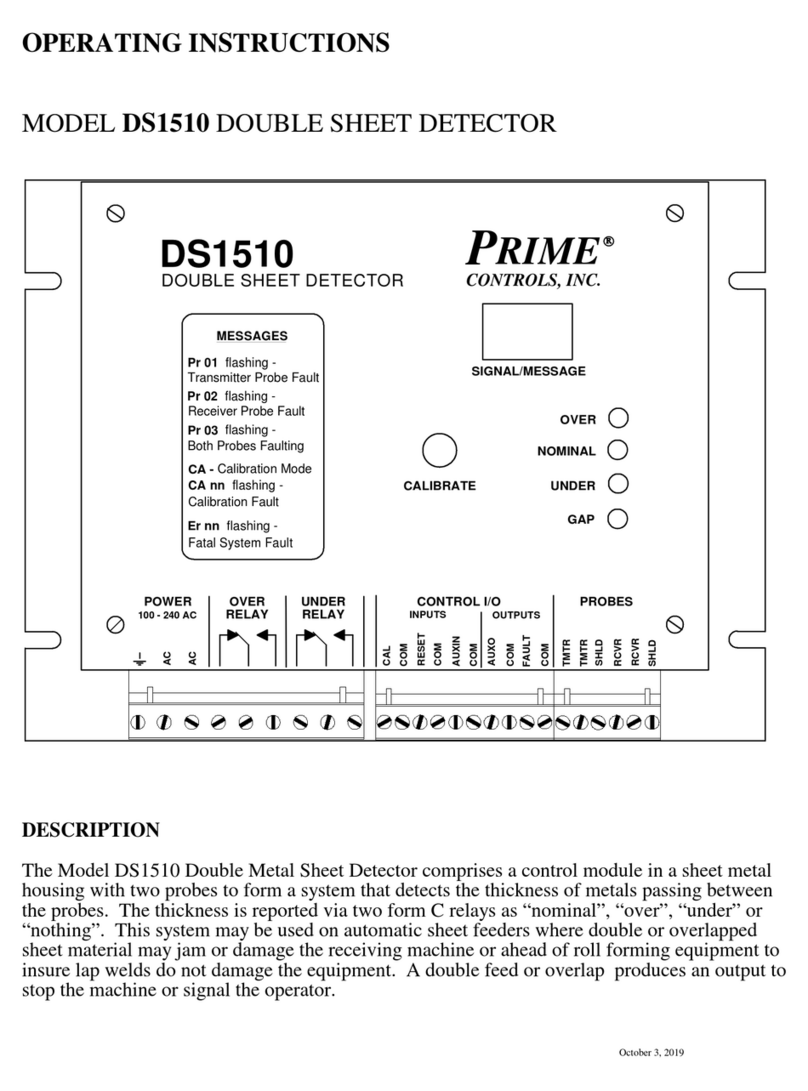
Prime Controls
Prime Controls DS1510 User manual

Prime Controls
Prime Controls SD220 User manual
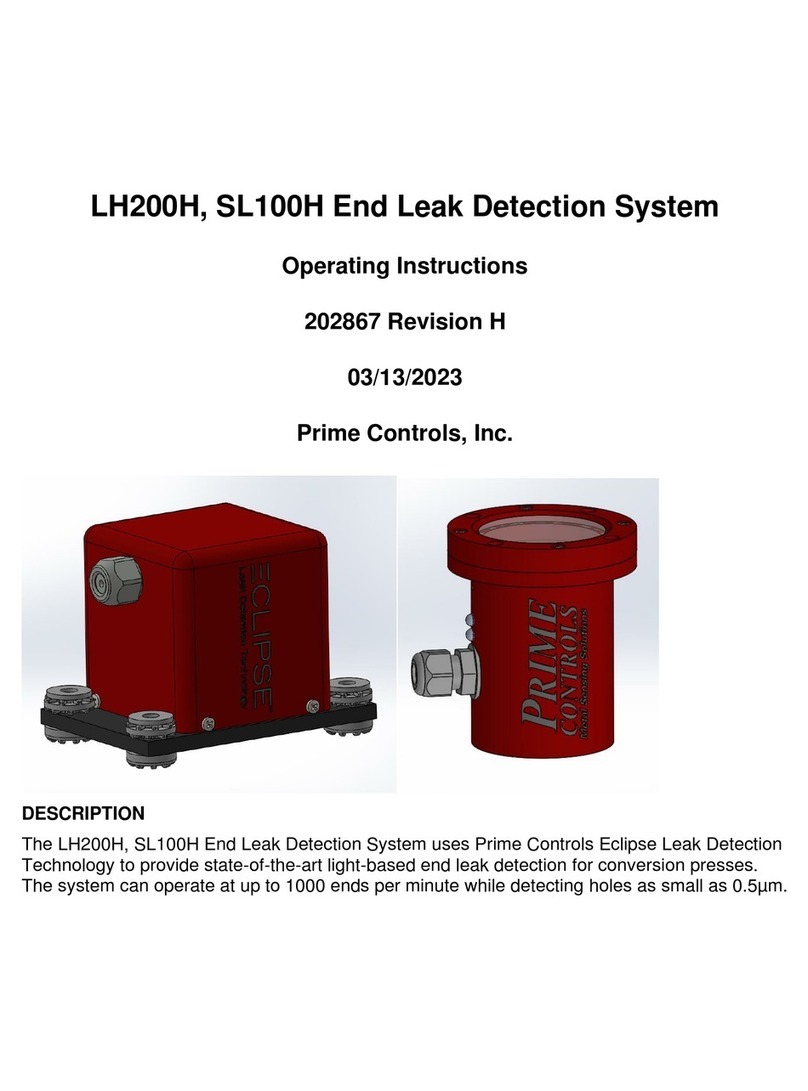
Prime Controls
Prime Controls LH200H User manual

Prime Controls
Prime Controls LH200 User manual

Prime Controls
Prime Controls DS600 User manual
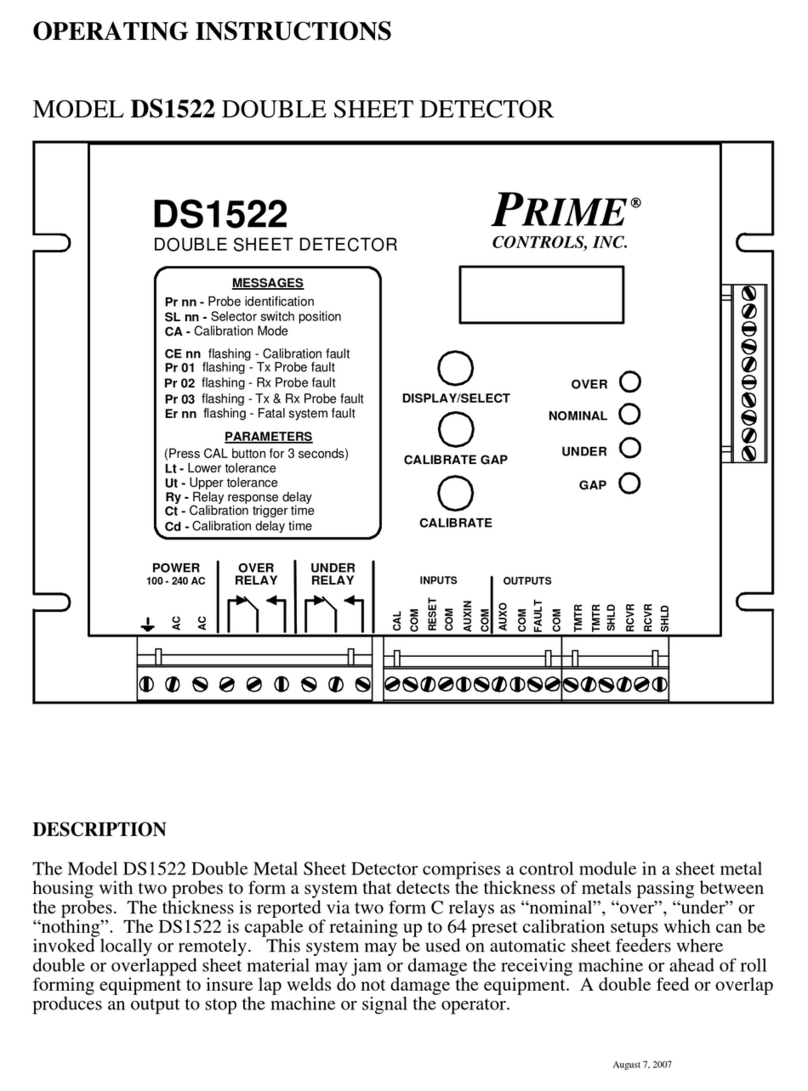
Prime Controls
Prime Controls DS1522 User manual
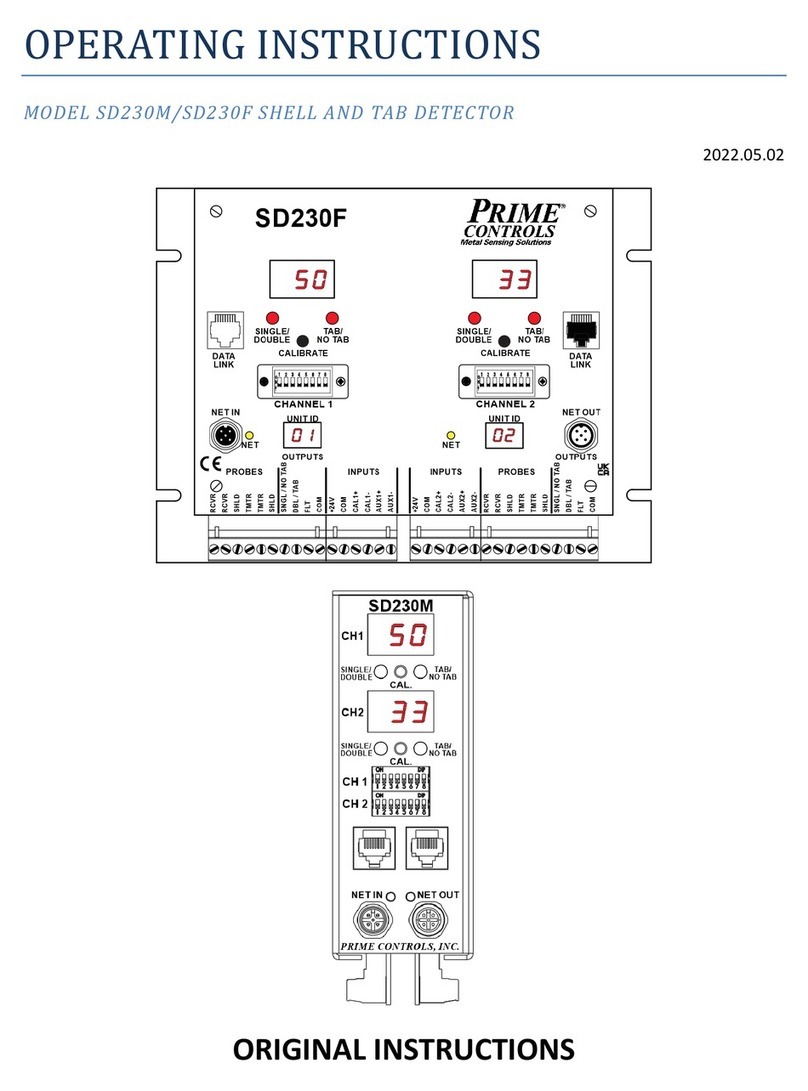
Prime Controls
Prime Controls SD230M User manual
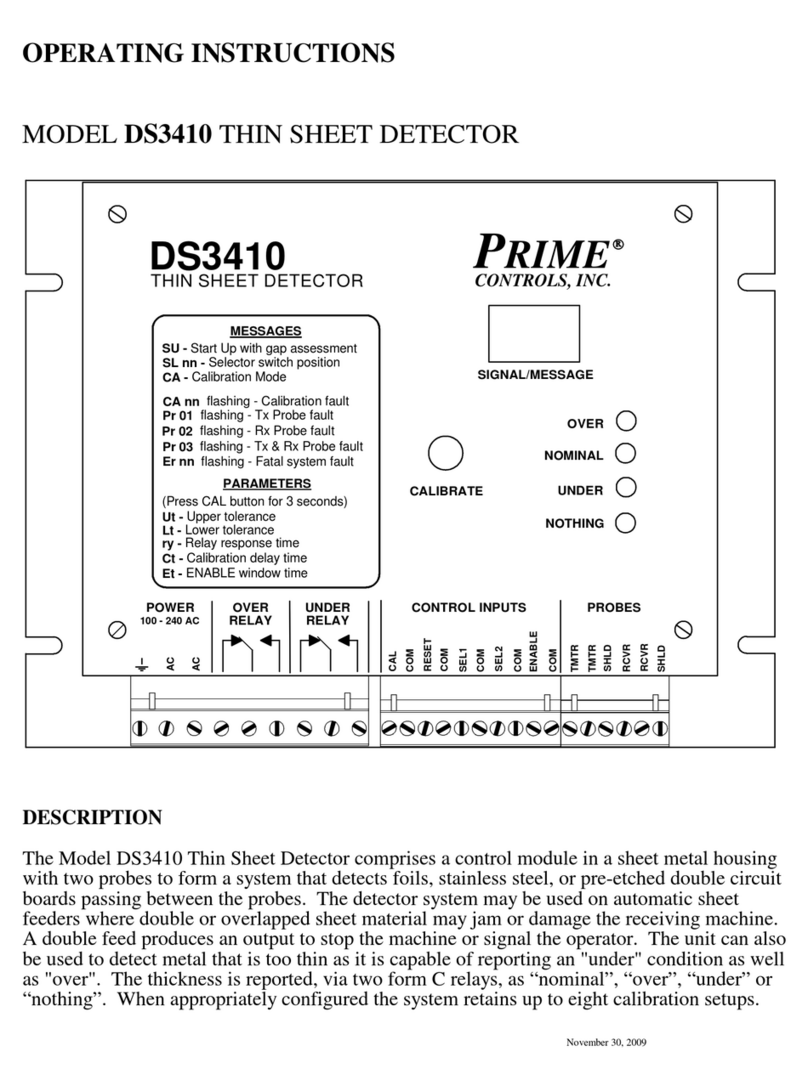
Prime Controls
Prime Controls DS3410 User manual
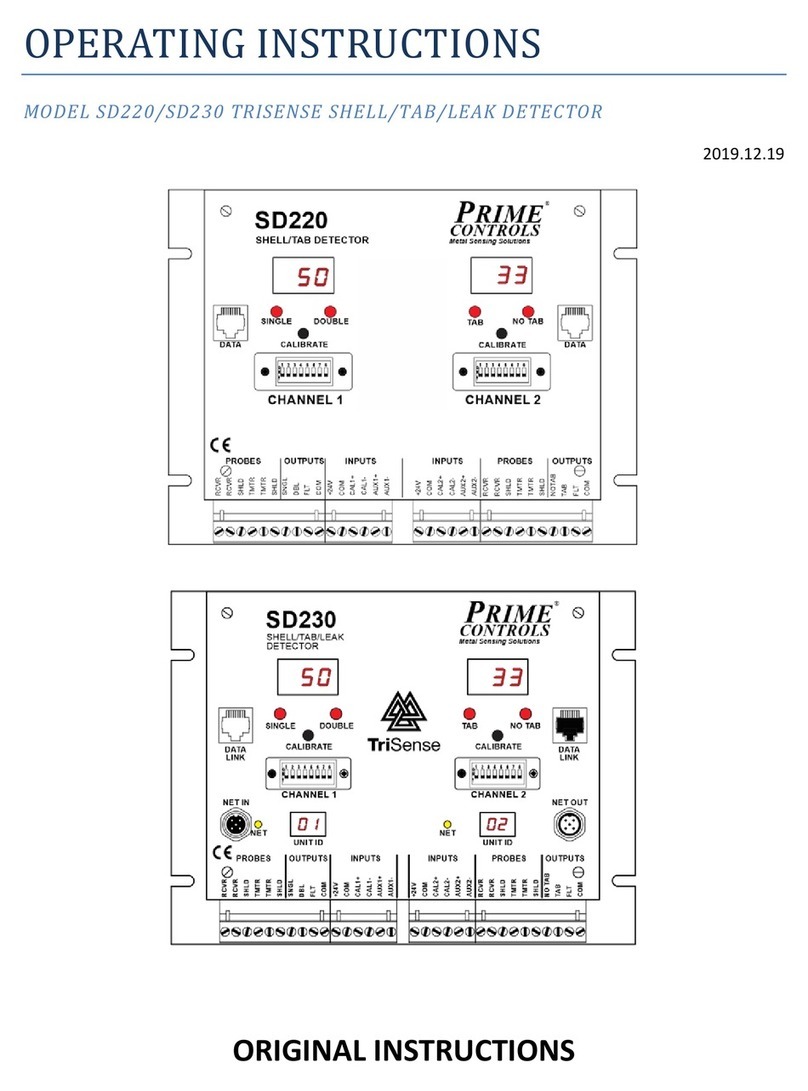
Prime Controls
Prime Controls SD220 User manual

